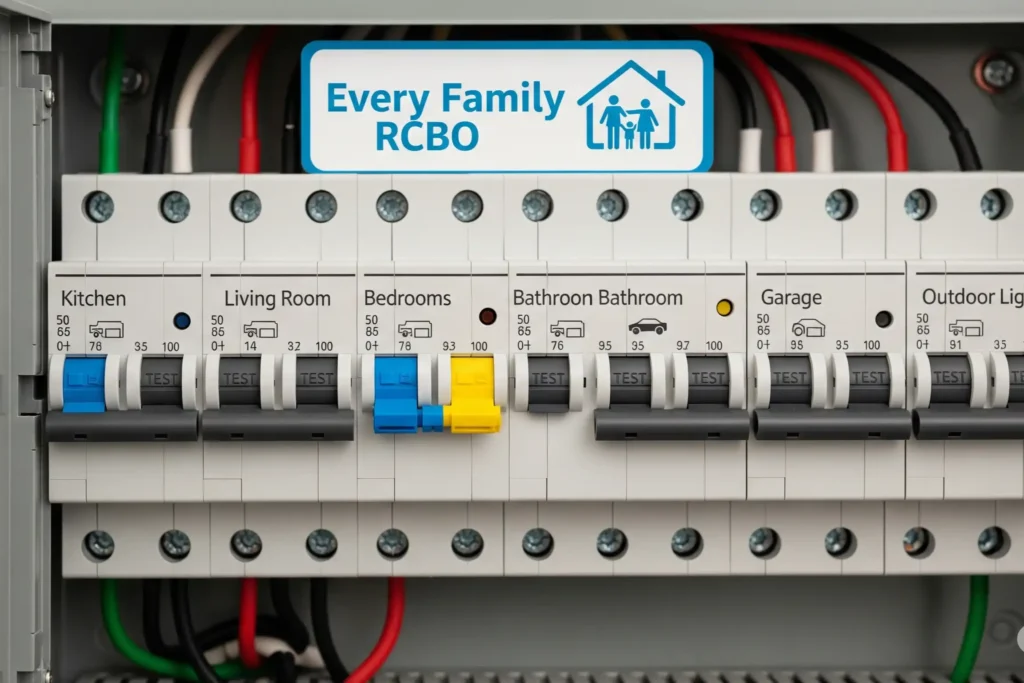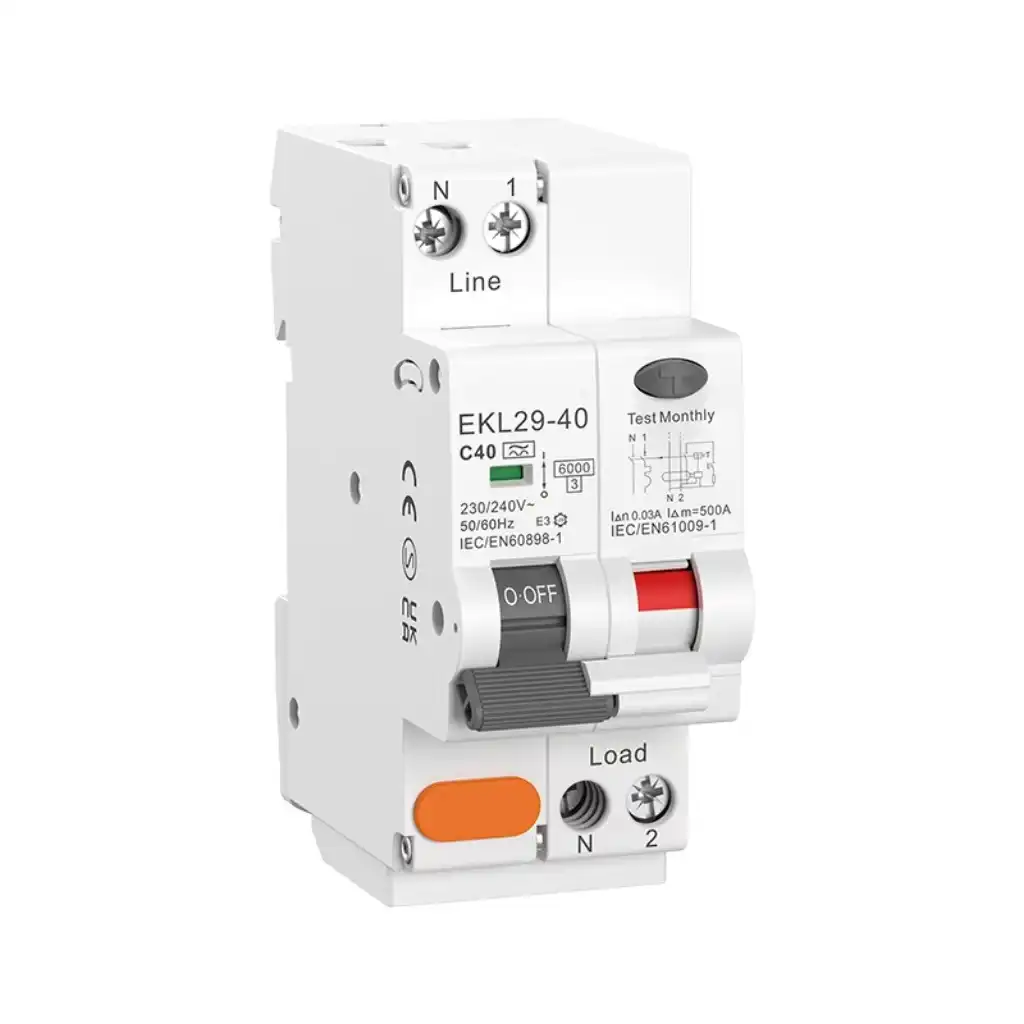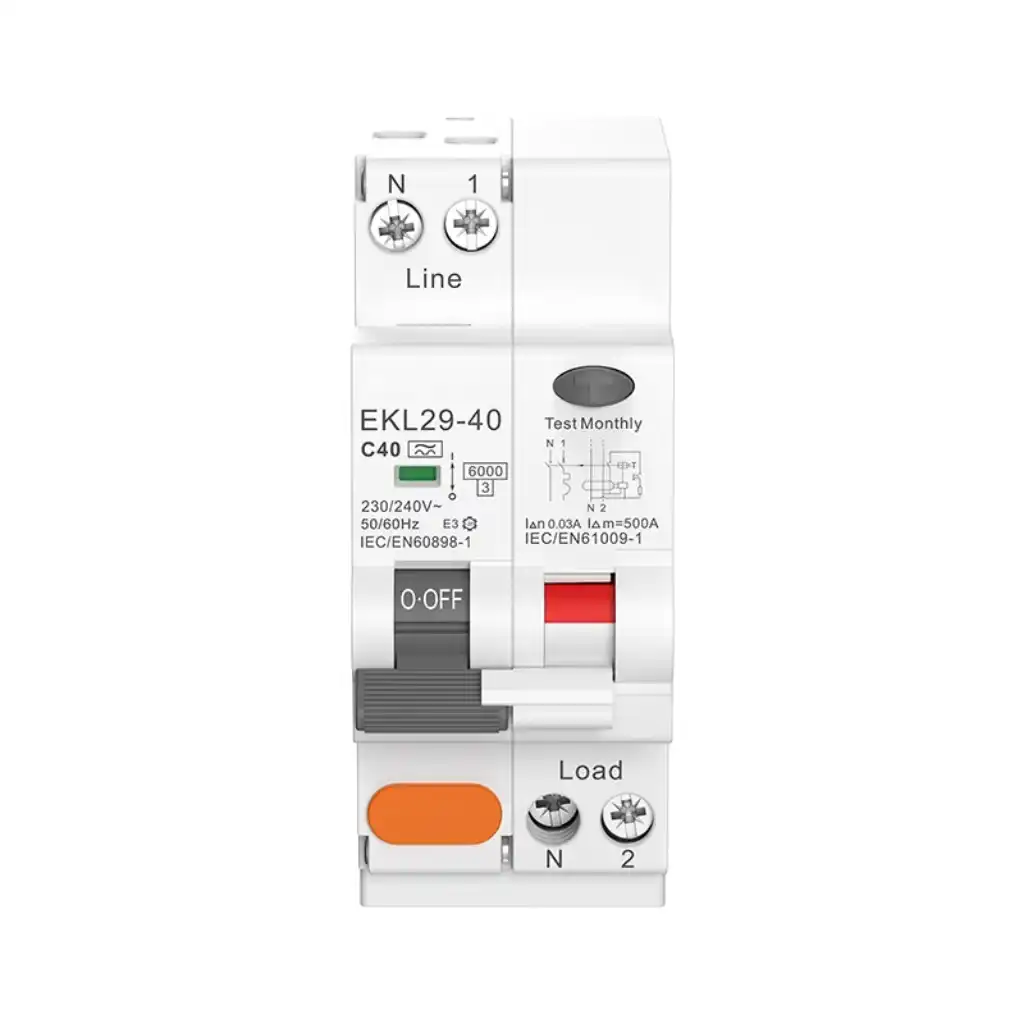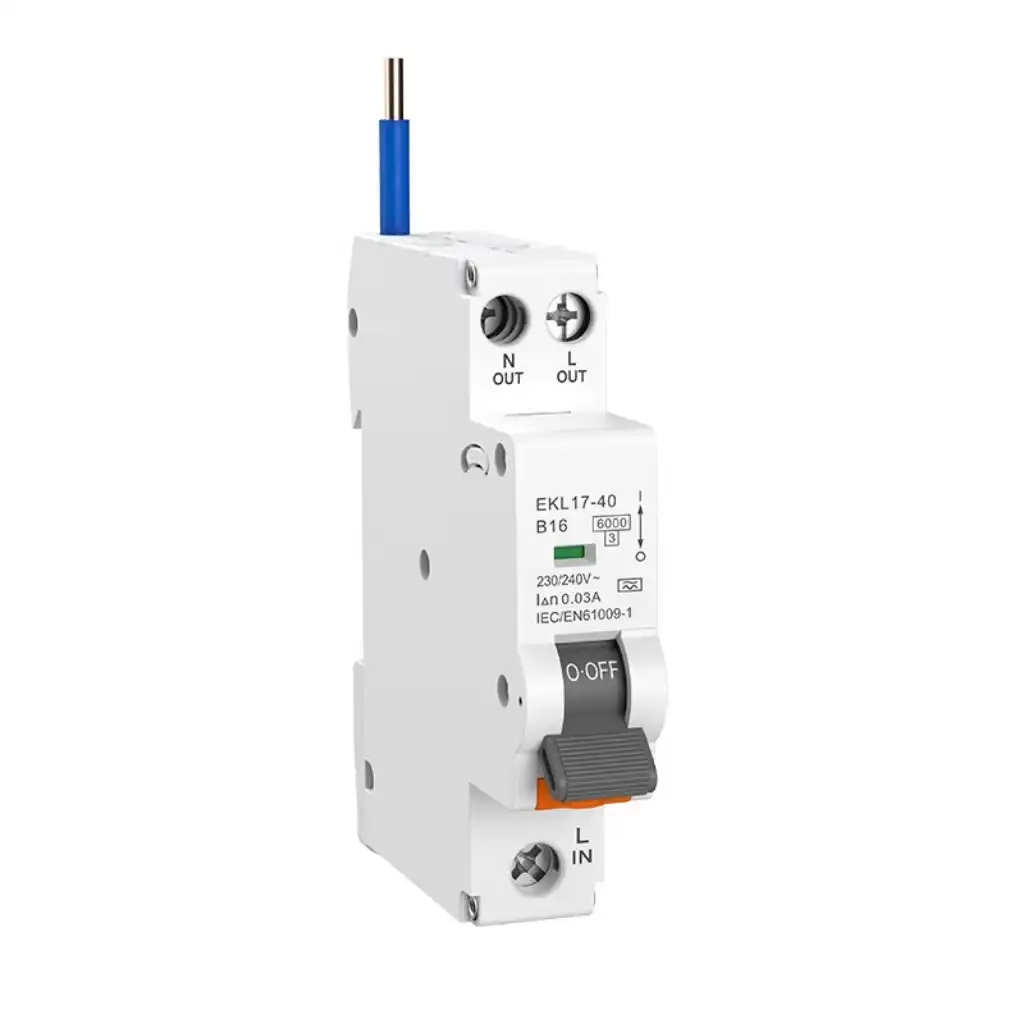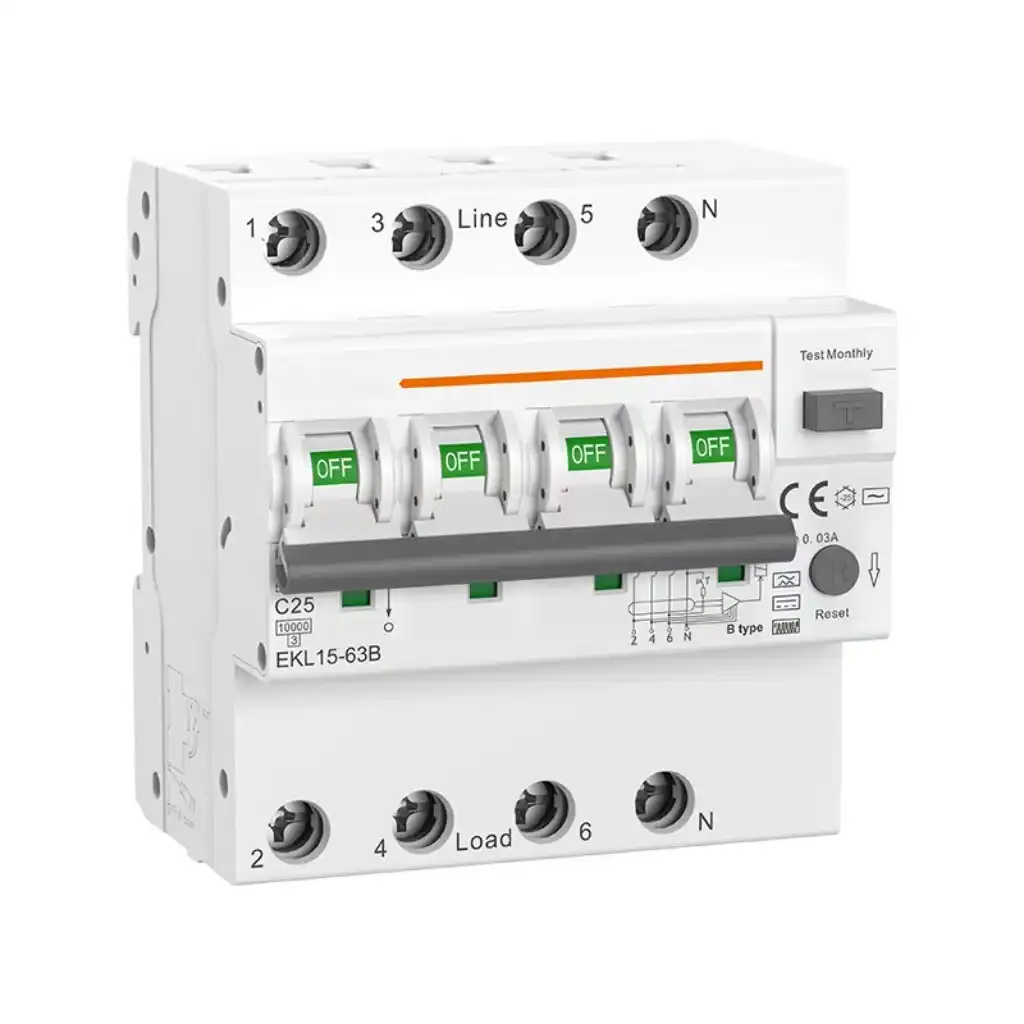Every household RCBO type keeps you safe from different electrical dangers at home. An RCBO is a device with two safety jobs. It stops too much electricity from flowing. It also finds dangerous earth leakage. You should know how each type is different to keep your home safe. Think about the things you use every day. Each one might need its own kind of protection.
Key Takeaways
- RCBOs keep your home safe. They stop too much electricity. They also find dangerous leaks. This helps prevent shocks and fires.
- Type AC RCBOs work for simple circuits. They do not protect modern electronics. They cannot stop DC leakage.
- Type A RCBOs fit most modern homes. They protect against AC faults. They also stop pulsating DC faults from daily devices.
- Type F RCBOs work with appliances that use frequency converters. These include air conditioners and dishwashers. They give extra safety.
- Type B RCBOs give the best protection. They are good for homes with solar panels or EV chargers. They can find all types of leakage.
What Are RCBOs
Dual Protection Function
An RCBO helps keep your home safe from two big dangers. It works like both a miniature circuit breaker and a residual current device.
- The miniature circuit breaker part stops too much electricity. It acts when there are overloads or short circuits. This can happen if you use too many devices or if a wire breaks.
- The residual current device part looks for leaks in electricity. It checks the flow between live and neutral wires. If it finds a difference, some electricity is escaping. This could be through a person or a broken wire. The RCBO shuts off power fast to protect you.
RCBOs turn off the circuit if they find too much current or a leak. This helps stop electric shocks and fires. You can check the device to see why it turned off.
You save room in your switchboard because one RCBO does two jobs. This makes setting up easier and keeps things neat.
Why They Matter in Homes
There are many electrical dangers at home. RCBOs help stop these problems quickly.
1. Too much current can happen with broken appliances or damaged wires.
2. Electricity leaks may come from bad wiring or mistakes during home projects.
3. Electric shocks are a risk, especially in bathrooms and kitchens.
4. Fires can start from too much current or electricity leaks.
5. Special devices, like computers, need protection from electrical trouble.
A household RCBO helps keep your family and things safe. It gives you safety in every room, especially where water and electricity are close. Modern homes need RCBOs to meet safety rules and protect everyone.
Household RCBO Types
Type AC
Type AC RCBOs only find AC leakage currents. You use them for simple electrical systems. These systems do not have electronic parts. Type AC works well for basic home circuits and old appliances.
- Finds only AC sinusoidal residual currents
- Good for lights and old appliances
- Not good for modern electronics with DC leakage
Note: Type AC RCBOs help stop electric shocks and fires in simple homes. They save space by doing two jobs in one device.
| Feature | Description |
|---|---|
| Sensing Capability | Finds only AC sinusoidal residual currents. |
| Typical Applications | Good for basic home loads like lights and old appliances. |
| Unique Advantage | Best for simple setups without DC, giving two protections in one device. |
| Limitation | Cannot find DC currents from new electronics, so not good for those circuits. |
| Impact of Limitation | May not protect homes with new electronics, solar, or EV chargers. |
| Arc Fault Detection | Does not find arc faults unless it has AFDD technology. |
Today, most experts do not pick Type AC for new homes. Modern homes use devices that make DC leakage. You need better protection for these.
Type A
Type A RCBOs find both AC and pulsating DC leakage. You see them in most new homes. They protect circuits with electronic devices.
- Protects home and office circuits
- Works with normal AC appliances, outlets, and lights
- Needed for electronics like chargers and washing machines
Type A RCBOs give good protection for most home devices. They combine two protections, so they are the best for new homes. Use Type A for showers, cookers, and devices with electronic controls. Most safety rules now say to use Type A at home.
Tip: If you have lots of electronics, Type A RCBOs keep you safe.
Type F
Type F RCBOs find more complex fault currents. They work with AC, pulsating DC, and mixed currents up to 1 kHz. You need Type F for circuits with frequency converters or variable-speed drives.
- Finds mixed-frequency fault currents up to 1 kHz
- Good for appliances with frequency converters
- Works if smooth DC current is not over 10 mA
| Detection Capability | Description |
|---|---|
| Frequency Range | Finds currents with mixed frequencies up to 1 kHz |
| Waveform Types | AC, pulsating DC with smooth DC up to 10 mA, mixed currents |
| Typical Application | Circuits with frequency converters, variable-speed drives |
You use Type F RCBOs for things like:
- Air conditioners with speed drives
- Dishwashers
- Washing machines
- Dryers with special motors
Type F gives more protection than Type A. It covers appliances that make complex currents. These are common in homes with new white goods.
Note: If you have appliances with frequency control, Type F RCBOs are safer than Type AC or Type A.
Type B
Type B RCBOs give the most protection. They find all leakage currents, even pure DC. You need Type B for homes with EV chargers or solar power.
- Finds AC, pulsating DC, and smooth DC leakage
- Needed for EV chargers and solar systems
- Uses smart tech for fast action
Type B RCBOs protect you from shocks and fires from any leakage. They cut power right away if they find a problem. This keeps your home and devices safe. They also stop false alarms, so your EV charger or solar works well.
You should use Type B RCBOs for:
- Three-phase EV chargers
- Solar systems
- Any circuit with mixed AC/DC leakage
Tip: If you have solar or an EV charger, Type B RCBOs are the safest.
But, Type B RCBOs trip at 3-5 times their rated current. They work best with loads that do not need high starting power. They may not be good for circuits with tools that need a lot of power to start.
Comparing RCBO Types
Detection Capabilities
It is important to know what each RCBO type can find. This helps you pick the right one for your house. Each type looks for different electrical problems. The table below shows what each RCBO type can sense:
| RCBO Type | Leakage Currents Detected | Typical Usage / Sensitivity |
|---|---|---|
| Type AC | Pure AC leakage currents | Obsolete; no longer recommended for modern use |
| Type A | AC + pulsating DC leakage currents | Suitable for most modern home and office circuits |
| Type F | Mixed-frequency currents (up to 1kHz), AC, pulsating DC, smooth DC up to 10mA | Best for appliances with frequency converters |
| Type B | AC + pulsating DC + smooth DC | Needed for EV chargers, solar PV, UPS, drives |
Type A RCBOs can find more problems than Type AC. Type B RCBOs find the most types of leakage, even smooth DC. Type F RCBOs work best with appliances that change speed.
Applications
Different RCBO types are used in different places at home. Each one is made for a special job. Here are the most common uses for each type:
- Type AC:
- Used for simple lights and sockets in older homes.
- Not good for circuits with electronics or devices that make DC leakage.
- Type A:
- Protects most home circuits, like those with chargers and kitchen appliances.
- Works well for outlets and lights with modern devices.
- Type F:
- Best for appliances with speed control, like dishwashers and air conditioners.
- Needed when you have equipment that changes frequency.
- Type B:
- Used for EV chargers, solar power, and circuits with inverters.
- Needed for homes with renewable energy or electric car charging.
| RCBO Type | Recommended Household Scenarios | Description |
|---|---|---|
| Type AC | Lighting and sockets in older homes | For simple AC circuits without electronics |
| Type A | Most home circuits with modern appliances | Protects against AC and pulsating DC faults |
| Type F | Appliances with frequency converters | Ideal for dishwashers, washing machines, air conditioners |
| Type B | EV chargers, solar PV, inverters | Needed for complex loads and renewable energy |
Tip: Pick the RCBO type that matches your devices. Modern homes often need Type A, Type F, or Type B for full safety.
Pros and Cons
Each RCBO type has good and bad points. You should think about these before you choose one for your home.
- Type AC
- ✅ Simple and cheap for basic circuits.
- ❌ Only finds AC faults. Not safe for circuits with electronics.
- ❌ Not good for new homes.
- Type A
- ✅ Finds both AC and pulsating DC faults.
- ✅ Good for most modern appliances.
- ❌ May not protect against all DC leakage.
- Type F
- ✅ Handles mixed-frequency and some smooth DC faults.
- ✅ Best for appliances with speed control.
- ❌ Costs more than Type A or Type AC.
- ❌ Not needed for every circuit.
- Type B
- ✅ Finds all types of leakage, even smooth DC.
- ✅ Needed for EV chargers and solar systems.
- ❌ Costs the most.
- ❌ May trip with high starting currents.
Note: You get the best safety when you pick the right Household RCBO for each circuit. Think about what devices you use and where you need extra safety.
Choosing a Household RCBO
Assessing Home Needs
You should think about your home’s electrical needs first. Check what devices you use and how much power they need. Make sure the RCBO can handle all the current from your wires. If you have smart home devices, remember that modern electronics can make both AC and DC leakage currents. Type A RCBOs are best for these devices.
Here are some things to look at:
- Pick an RCBO that fits your circuit’s current.
- Check the overcurrent class to match your appliances.
- Decide if you want selective or non-selective tripping so you do not lose power everywhere.
- See how quickly the RCBO turns off when there is a problem.
- Stop unwanted tripping by making sure connections are tight and the RCBO is the right size.
- Always check the safety rating of the RCBO.
- Learn simple troubleshooting steps for your RCBO.
The table below shows how Type AC and Type A RCBOs work for different homes:
| Feature | Type AC RCBO | Type A RCBO |
|---|---|---|
| Detects AC | Yes | Yes |
| Detects Pulsating DC | No | Yes |
| Best For | Older circuits | Modern homes with electronics |
| Safety Level | Basic | Enhanced |
| Future-Proof | Limited | Good |
Tip: Type A RCBOs are better for smart homes and meet new safety rules.
Safety and Compliance
You must follow safety rules when you put in a Household RCBO. In the United States, the National Electrical Code says you need RCBOs to stop electrical dangers. In Europe, rules like DIN VDE 0100-520 and EN 60998 help keep wiring safe. Always use RCBOs with approval marks like VDE or ENEC. Installers should pick approved devices and follow these rules to keep your home safe.
When to Get Professional Help
Call a licensed electrician if you are not sure about your wiring or panel. You need expert help for big upgrades, like adding new circuits or putting in RCBOs for solar panels. Electricians know local codes and can check if your panel is ready for new devices. They make sure your setup meets safety rules. Never try to change breakers or wiring by yourself. Some brands have special needs that only professionals know. Getting help from an expert keeps your home safe and your insurance valid.
You make your home safer when you pick the right RCBO for each circuit. Each RCBO type gives special protection from shocks, fires, and too much power. The table below shows how each RCBO type switches and handles short circuits:
| RCBO Type | Neutral Switching | Short-Circuit Capacity | Typical Use Case |
|---|---|---|---|
| Single-Pole (SP) | No | No | Used for most home circuits |
| Single-Pole & Neutral (SP&N) | Yes | No | Used when both wires need switching |
| Double-Pole (DP) | Yes | Yes | Used for special setups |
- You keep your family safest when you match RCBOs to your devices and how your home is wired.
- Always talk to a licensed electrician before you choose or install an RCBO.
- Update old systems so they follow new safety rules and protect your home.
FAQ
What does an RCBO do in your home?
An RCBO protects you from electric shocks and fire. It stops the power if it finds too much current or a leak. You get two safety features in one device.
What type of RCBO should you use for most modern homes?
You should use Type A RCBOs for most modern homes. They protect against both AC and pulsating DC faults. This type works well with electronics and appliances you use every day.
What makes Type B RCBOs different from other types?
Type B RCBOs detect all types of leakage, including smooth DC. You need them for circuits with EV chargers or solar panels. They give you the highest level of protection.
What happens if you use the wrong RCBO type?
If you use the wrong RCBO, you may not get full protection. Some faults can go undetected. Your home and devices stay at risk for shocks or fire.
What should you check before choosing an RCBO?
Always check your appliances and wiring. Look for the type of current your devices use. You should match the RCBO type to your home’s needs for the best safety.
See also
What Are the Different Types of Residual Current Circuit Breakers
8 Big Benefits of Upgrading to Miniature Circuit Breakers
RCBO residual current circuit breaker with overcurrent protection
Understanding RCBO Breaker Terminology Made Simple
RCBO and RCCB Explained for Beginners

